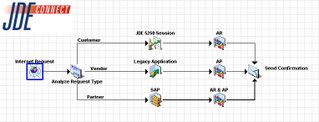Sure life flows on, but do your business processes? As discussed earlier, the
JDE Connect/iBOLT system helps you create smooth running business processes between your J.D. Edwards ERP system and the other applications and workflow processes that surround it. JDE Connect connects you to websites, portals, homegrown
RPG applications, third party applications and even human workflow (such as SMS or email, etc.) with all the security and operational integrity measures you desire.
We've discussed in previous entries how
JDE Connect lets you define a
topology that describes the physical relationship between your servers and applications and also allows you to model a high level
business process view.
These are essentially preparatory steps taken before the real task at hand which is to create an executable business process. To create a smooth-running business process, you need to define the actual steps and tasks in that process. With JDE Connect, this is accomplished using the
iBOLT Flow Editor, a very useful visual editor with drill-down functionality for defining logical conditions, expressions, and branches using required services, triggers and schedules. In other words, you use the flow editor to visually dictate how the JDE Connect/iBOLT Server will execute your business rules. This approach gives you complete control over how the integration of procedures, websites and applications outside JDE are handled. The advantage of the visual editor is that it allows business analysts and system architects to implement and modify business rules without the need for programming and it documents the flow of these business rules in a way that is easily understood.
A flow is where you define integration processes that are part of your topology. Within your flow, you include flow components to manage integration processes. You can also define an error handling policy for the flow.
Let's consider at a high level, the kind of power JDE Connect gives you over your business processes:
JDE Connect Understands When to Act Triggers, schedules and branching let you control when steps in your business process are executed. JDE Connect can use triggers to monitor events and execute a flow each time that event occurs. JDE Connect can execute a flow on a schedule or interval that you specify. JDE Connect can group your actions in branches that follow steps in a procedure one at a time (serially) or all at once (in parallel). You create a flow by inserting flows into the Flow Editor. The Flow Editor has Trigger and Flow areas. Components that trigger a flow automatically are placed in the Trigger area. Components that are part of the flow are placed in the main Flow area. The flow is executed in the order that you place the components. However, you can move a branch of components to change the branch order.
JDE Connect Understands Whether to Act JDE Connect allows you to set conditions for any step in a process. You can use conditions, or rules, to define the flow's execution behavior and create Flow Logic. You can conditionally specify the execution sequence of the flow components by setting the conditions, the condition execution point in the flow, and which flow component is executed when the condition is True or False.
JDE Connect Understands How to Act If you had to build all of your business processes from scratch by building up logical routines for common procedures, that would be a lot of unnecessary work. Instead, JDE Connect/iBOLT's out-of-the-box flow components have been developed to let you use the different iBOLT services.
When you develop your flows, you can configure the components to utilize iBOLT services. The iBOLT services are building blocks that provide the project architect more control over the project and are used to specify specific behavior while modeling the project. Adding services to a flow is as easy as dragging the Service into the flow.
The various services available within JDE Connect/iBOLT for quickly building processes that incorporate a best practices approach to business automation are: Data Mapper Service, Scheduler Service, Locking Services, Logical Name Service, Delay, Publish and Subscribe Services, Enable Flow Service, Wait for Event Service, Post Event Service, Flow Data Service (ODS and Variables), Flow Manager, Save Message, BAM Service, SNMP Service, Java Class Connector Service, and EJB Connector Service.
In our next post, we will overview the available components within JDE Connect. Life flows on. Blog you later!

